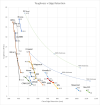I was trying to think of a way to visualize the effect of blade thickness and edge angle on toughness and edge retention at the same time.
A convenient mathematical relationship is that toughness is proportional to the cube of blade thickness, while edge retention is related both to the contact force at the blade tip and the thickness of the edge bevel: the larger the edge angle is, the thicker the edge bevel is, and the less contact pressure there is on the material being cut at the actual edge. As the edge wears away, contact pressure is reduced further until the blade ceases to cut.
Empirical data on edge angle and edge retention gives the relationship:
Edge Retention ∝ (sin(Edge Angle/2))^(-9/4)
If we reduce the blade thickness while keeping the bevel height the same, the bevel thickness decreases proportionally with blade thickness and we can get a simple relationship between toughness, edge retention and thickness.
Bevel Thickness ∝ sin(Edge Angle/2)
Edge Retention ∝ (Bevel Thickness)^(-9/4)
Edge Retention ∝ (Thickness)^(-9/4)
Since Toughness ∝ (Thickness)^3, we can use the results above to get the relationship:
Edge Retention ∝ (Toughness)^(-3/4)
And this can be visualized as such:

The dashed lines show the effect of reducing the blade/bevel thickness (and edge angle), confirming that edge angle can be even more important than the steel type.

